If you are not sure how accurate your digital multimeter measurement is, find its accuracy specifications in the instruction manual, and then read this to get the rest of the story.
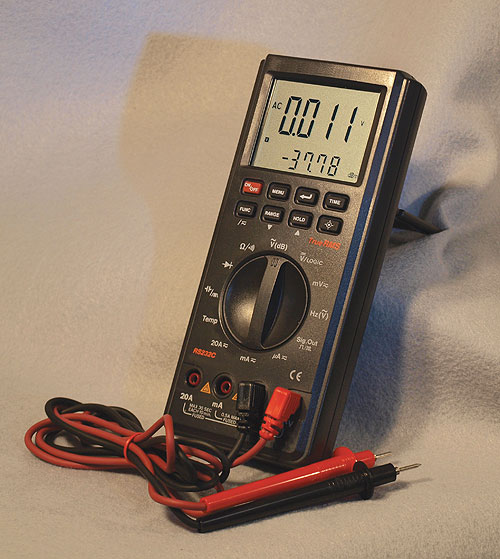
Most hand-held DMMs are more accurate than you might expect, including the least expensive models. In addition to volts, ohms, and amperes, many can also measure frequency and capacitance.
The accuracy of an electronic measurement defines how close the indicated value is to the true value of the measured signal. Analog meters usually have their accuracy listed as a percentage of the full-scale reading. When a measured value is close to full scale, or at least above 2/3 of full scale, the published accuracy is meaningful. However, the further away the reading is from full scale, the greater it can deviate from the true value when viewed as a percentage of reading, not as percentage of full scale.
For example, an analog voltmeter with a ±3% accuracy is set to the 0 to 100-V range. Based on this accuracy, its pointer can be 3 volts (100 V x 0.03 = 3 V) below or above the true reading. If the true measured value is, for example, 90.0 V, the meter might read between 87 V and 93 V or ± 3.3% of reading. However, 10.0 volts measured on a 100-V scale of the same voltmeter can read between 7 V and 13 V, or ± 30% of the actual reading, while the meter is technically within specifications. So, to maintain reasonable accuracy, select the analog meter range that places the pointer between 2/3 of full scale and full scale.
Compared to analog meters, digital multimeters (DMM) have many practical advantages. They present measurement data in a direct format that does not require calculating the exact value, and they are free from the parallax error of analog meters. Unlike meter movements in analog meters, digital multimeter displays have no moving parts, and they are free from wear and shock failures. DMMs automatically detect polarity, show positive and negative values, have much better overload protection, and offer automatic as well as manual range selection options.
All these features lead many DMM users to believe that because the meter displays the measured value in direct decimal format the number shown is the true value of the measured parameter. Others read the meter manual to find the basic accuracy specifications, for example ±2%, and expect all readings to be within this margin of error. However, to calculate the actual deviation from the true value that the meter manufacturer can claim and still be within specifications requires a much deeper understanding of the published electrical meter specifications. For example, first, look at how DMM resolution and ranges affect accuracy, then read the examples that follow and learn what the meter manufacturers really mean.
Display digits, DMM counts, and resolution
Most hand-held DMMs have a so-called “3½-digit” display. The three full numeric characters on the right can show any value from 0 through 9, but the leading (most significant) digit can be only 0 or 1, and is called the “½ digit.” Such meters can display numbers from 0 to 1999. They are also known as 2000-count DMMs.
DMM resolution depends on the maximum number of analog-to-digital converter (ADC) counts during a full conversion. For example, the theoretical resolution of a 2000-count meter with a 3½-digit display is (1/2000)(100%) = 0.05%. However, a practical resolution also accounts for the number of least significant counts — similar to the accuracy rating.
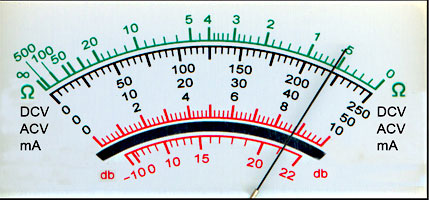
The most accurate reading for an analog meter is a pointer position between 2/3 of full scale and full scale.
Typically, dc voltage measurements use the full count capability of the ADC, since signal conditioning is rather straight forward: it uses resistive dividers and filters. Other functions might be limited in range or require signal conditioning that limits the ADC input range and gives a coarser resolution. High resolution, hand-held DMMs often have a 4½-digit display (20000 count) and can display any value from 0 to 19999. The 40000-count meters have a 4¾-digit display and can represent any value from 0 to 39999. Somewhere in the middle are 3¾-digit displays or 4000-count DMMs. Many DMMs temporarily blank the leading digit when it contains a zero.
The larger number of counts should translate into higher resolution, and usually DMMs with a higher resolution have higher accuracy. However, DMM accuracy also depends on other design factors, such as ADC accuracy, component tolerances, noise level, and the stability of internal references. So, do not automatically assume that a 4½-digit meter is 10 times more accurate than a 3½-digit meter. In addition, since DMMs have automatic polarity detection, they display negative values equal in range to the positive values. That is, the display of a 3½-digit DMM can show any number from -1999 to 0 and from 0 to 1999.
Ranges
Select the highest range first to keep the meter safe from damage, then switch to progressively lower ranges to obtain the most accurate measurement available on a given meter. Range selection on the least expensive DMMs is usually manual: the user sets the rotary switch to the appropriate range of the desired function. For example, a typical selection of available ranges in dc volts of a 3½-digit DMM will include 200 mV, 2 V, 20 V, 200 V, and 1000 V (or some lower value). The top range is limited by the maximum voltage that the meter can safely handle.
For manual range-changing meters, switch to a range that provides the maximum number of digits for the unknown voltage. For example, when measuring a 1.5-V battery, the highest 1000 V range will only show “1”. Switching to the 200 V range will show 1.5 on the display, the 20-V range could display 1.52, and the most accurate reading is obtained in the 2-V range: perhaps 1.523. This will become more obvious in the following section on DMM accuracy.
DMM accuracy
Some instruction manuals list basic meter accuracy as ± % of reading. For example, if the basic meter accuracy in the dc volts range is ±1 %, and the true voltage is 1.00 V, the meter is expected to display a reading of 1.00 V ±1 %, or 0.99 V to 1.01 V. However, basic accuracy does not take into account the inner workings of the ADC (that is at the heart of every DMM) and other circuitry on the analog side. These circuits and the ADC have tolerances, nonlinearities, and offsets that vary from function to function. In addition, signal noise might require limiting the resolution. To give meter users a more accurate value, DMM manufacturers present accuracy specifications in the following format:
Complete accuracy specifications: ±(% of reading + number of LSD)
Where:
Reading = the true value of the signal that the DMM measures
LSD = least significant digit
The LSD represents the magnitude of uncertainty due to internal offsets, noise, and rounding errors. For a given DMM the number of LSDs varies from function to function and even from range to range for the same function. Accuracy and range selection need to be considered independently, otherwise a misunderstanding can lead to gross errors. For example, consider the following:
A 3½-digit display DMM measures an output of a precision 1.2-V reference. Presume that the true voltage is 1.200 V. The DMM manual shows the dc volts accuracy specification as ±(0.5% + 3). How should you measure the voltage and interpret the reading?
First, set the meter to the 200-V range. The display will indicate the measured voltage as XX.X. The percentage of reading is (1.200)(0.5)/100 = 0.006 V, which cannot even be seen on the display because only one digit after the decimal point is shown. However, when accounting for the three allowed LSD counts, realize that the last digit on the display can vary by ±3 counts. So, the meter can display a value of 1.2 ±0.3 V, or a range of 0.9 V to 1.5 V. This is a ± 25% potential error with all factors combined and is not acceptable for a precision measurement.
Set the switch to the 20-V range and it will display the value as X.XX, which improves the accuracy. The complete accuracy can be a calculated as ± (1.200)(0.5)/100 +0.03) = ± 0.036 V. So, any reading between 1.16 V and 1.23 V is within the accuracy specifications. This complete accuracy is ± 3% of reading, which is better, but still not accurate enough.
Finally, set the DMM to the 2-V range. The display format changes to X.XXX. The percentage of reading does not change, but the third LSD becomes a smaller factor. The complete accuracy can be a determined as ± (1.200)(0.5)/100 +0.003) = ± 0.009 V. The meter display is only allowed to be within the narrow 1.191 V to 1.209 V range. Now the complete accuracy is only ± 0.75% of reading, which is sufficient for the measurement. So, selecting the lowest measurement range before the DMM over-ranges reduces the negative effect of the number of LSDs and gives the most accurate results.
Time, temperature, and humidity
When was your meter manufactured or recalibrated? Most meter manufacturers and calibration services guarantee accuracy specifications only for one year. After that, the DMM might not keep its accuracy within published limits. So, if accuracy must be guaranteed, the meter must be calibrated about once a year.
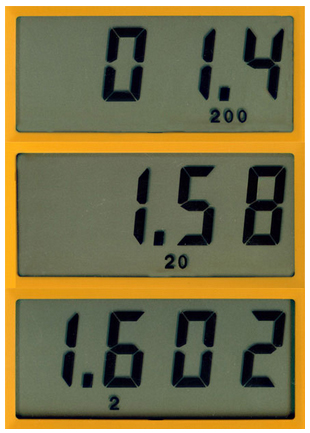
The most accurate reading for a digital meter is in the lowest range that shows the most significant digit in the left-most position. Select the lowest measurement range on the DMM before it over-ranges to read the most accurate results. For example, in the first figure, a DMM reads an unknown low voltage (which appears to be 1.4 V) as displayed on the 200-V dc range. Initially, the reading looks acceptable. However, switching to the 20-V dc range improves the accuracy; the reading is now 1.58 V because the least significant digit (LSD) error is pushed into the hundredths of a volt position. Finally, after switching the DMM to the 2-V dc position, the reading is 1.602 V. It then becomes obvious how the LSD counts can become a more significant source of error than the accuracy when the range selection is not considered.
Do not use the meter when the ambient temperature is higher or lower than the specified operating temperature range. In addition to the operating temperature specifications of electronic components inside the meter, LCD displays are notorious for becoming sluggish and eventually going blank at subfreezing temperatures. At high temperatures, LCDs display ghost images of the segments that are turned off, and they eventually darken.
Many high-quality DMMs produced by major manufacturers have an operating temperature range of 20° C to +55° C.
This wide temperature range guarantees that the meter will perform reasonably well under most indoor and outdoor conditions. However, beware of inexpensive meters: many are guaranteed to work reliably only between 0°C and +40°C. In any case, these specifications are true only when the relative humidity is below a specified value, usually 80 to 90%.
Do not confuse the operating temperature with the temperature range at which the manufacturer specifies meter accuracy.
Compared to the 20° C to 55° C operating temperature range,accuracy specifications are normally guaranteed only within a much narrower 18° C to 28° C (23±5° C) range — and often at a lower humidity level. Some meter specifications list a temperature coefficient value that helps calculate the accuracy of a specific function for the entire operating temperature range. A typical example of a temperature coefficient would be 0.05 times (specified accuracy) per each degree C between 20° C and 18° C and from 28° C to 55° C. However, do not assume that every meter will have the same temperature coefficient. If the meter manual does not list it, the loss of accuracy due to ambient temperature fluctuations might be much higher. Also, the effect of humidity increases at a higher temperature.
For more information:
You may also like:
Filed Under: Multimeters, SENSORS, TEST & MEASUREMENT



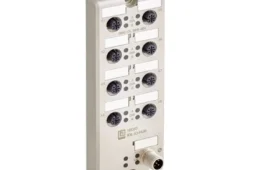
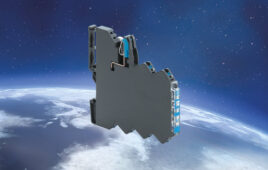
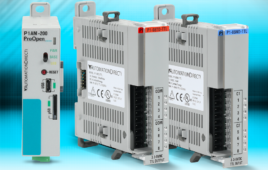
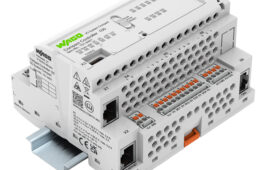
Thank you! This article really helped me with my laboratory report!
Thankyou very much fantastic article
Thank You for this Article, it helped a lot!
Finally, I understand the meaning of “number of LSD” – I’ll tell my friends.
A sensor has a defined linearity error of 1% of the output value plus
error 0.1% of full scale value. A second sensor, having the same
measuring range, respectively has an error of 0.5% of the output value plus an error of 0.2% of
full scale price.
(i) For what output range is the first sensor more correct than
secondly;
(ii) If the second sensor had twice the measuring range of the first, for which
price range would be more correct?
John,
Thx for sharing this article.
Your analysis is flawed. The total error is the stated tolerance at full scale, however any reading below F.S. has a scaled total error. In your example of 90V value that is 0.9*3% or 2.7% accuracy not your stated 3.3% accuracy. If you used your method then taking the limit to 0V then the meter would read +/-3V. That would correspond to an infinite tolerance, error/value. That doesn’t happen unless the meter’s “movement”, movement in this sense is the core ADC converter or an actual D’Arsonval movement, is broken. To recap the bounded error is a scaled value of the F.S. reading.
To simplify the subject I have left out the LSD, temp co, noise, humidity etc. contributors to better clarify what F.S. tolerance means.
The part that slays me is a meter that has 55000 counts but only has 0.5%+LSD accuracy. Essentially they are selling a 3.5 digit multi-meter with unusable extra digits all the while claiming extra accuracy with those extra digits.
Again, hope this clarifies the F.S. tolerance better “for young players”, as Dave would say.
Thanks a lot for sharing such knowledge
Hello. thanks a lot for this helpful post. i have one question: how can i useing Digital Multimeter for testing a maniadsanat thermocouple sensor? how can i se it for testing a rtd sensor like pt100 and pt1000?